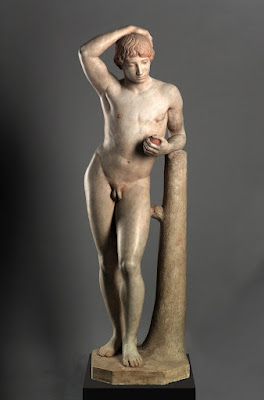 |
| Polidoro da Caravaggio St Sebastian ca. 1525 drawing Statens Museum for Kunst, Copenhagen |
-attributed-Man-attacked-by-Serpents-c1527-Cleveland-Museum-of-Art-Ohio.jpg) |
| attributed to Pordenone (Giovanni Antonio Licinio) Man attacked by Serpents ca. 1527 drawing Cleveland Museum of Art, Ohio |
 |
| Francesco Salviati Study of Twisting Figures ca. 1540 drawing Graphische Sammlung Albertina, Vienna |
 |
| Anthonie Blocklandt Venus disarming Cupid ca. 1580 oil on canvas Národní Galerie, Prague |
-St-Sebastian-c1590-oil-on-copper-Galleria-Borghese-Rome.jpg) |
| Domenico Cresti (il Passignano) St Sebastian ca. 1590 oil on copper Galleria Borghese, Rome |
 |
| Joseph Heintz the Elder Antique Statue of Bacchus and Panther ca. 1593 drawing Graphische Sammlung Albertina, Vienna |
-Figure-on-Ladder-1596-drawing-(study-for-painting-Descent-from-the-Cross)-Museum-of-Fine-Arts-Budapest.jpg) |
| Cigoli (Lodovico Cardi) Figure on Ladder 1596 drawing (study for painting, Descent from the Cross) Museum of Fine Arts, Budapest |
 |
| Cherubino Alberti Neptune, with Orb bearing Medici Arms 1628 engraving Hamburger Kunsthalle |
 |
| Andreas Schlüter Apollo pursuing Daphne 1712 sandstone Bode Museum, Berlin |
-Bode-Museum-Berlin.jpg) |
| Lambert Sigisbert Adam Bacchus ca. 1730 marble (incorporating antique torso) Bode Museum, Berlin |
 |
| attributed to Jacopo Amigoni Infants with Birds ca. 1740 oil on canvas Nasjonalmuseet, Oslo |
 |
| Jacques-Philippe-Joseph de Saint-Quentin Académie ca. 1765 oil on canvas Alte Pinakothek, Munich |
-Prins-Eugens-Waldemarsudde-Stockholm.jpg) |
| Eugen, Prince of Sweden Académie ca. 1887-89 drawing (executed as an art student in Paris) Prins Eugens Waldemarsudde, Stockholm |
 |
| Artur Volkmann Paris with Golden Apple ca. 1914-18 marble Alte Nationalgalerie, Staatliche Museen zu Berlin |
 |
| Man Ray Fashion Photograph 1930 gelatin silver print Moderna Museet, Stockholm |
-Moderna-Museet-Stockholm.jpeg) |
| Anonymous Swedish Designer Venetian - Nationalmuseum 1990 lithograph (exhibition poster) Moderna Museet, Stockholm |
I requested a horse, since I was an accomplished rider. When one was brought, I took him through his paces in a graceful display of the cavalry drill, and won high praise from the commander himself. He invited me to his table that day, and during dinner I responded to his inquiries by relating my entire history, to which he listened sympathetically. Compassion is a natural human response to a recital of wretched reversals, and pity is prompt to promote rapport. Feelings of sorrow soften the soul while troubles are being told, and by gradual degrees the auditor's pity mellows to amity, his grief to compassion. He was so moved by my story that he wept, but there was nothing more we could do as long as Leucippe was in the clutches of the outlaws. He assigned an Egyptian orderly to me to look after my needs.
– Achilles Tatius, from Leucippe and Clitophon (2nd century AD), translated from Greek by John J. Winkler (1989)